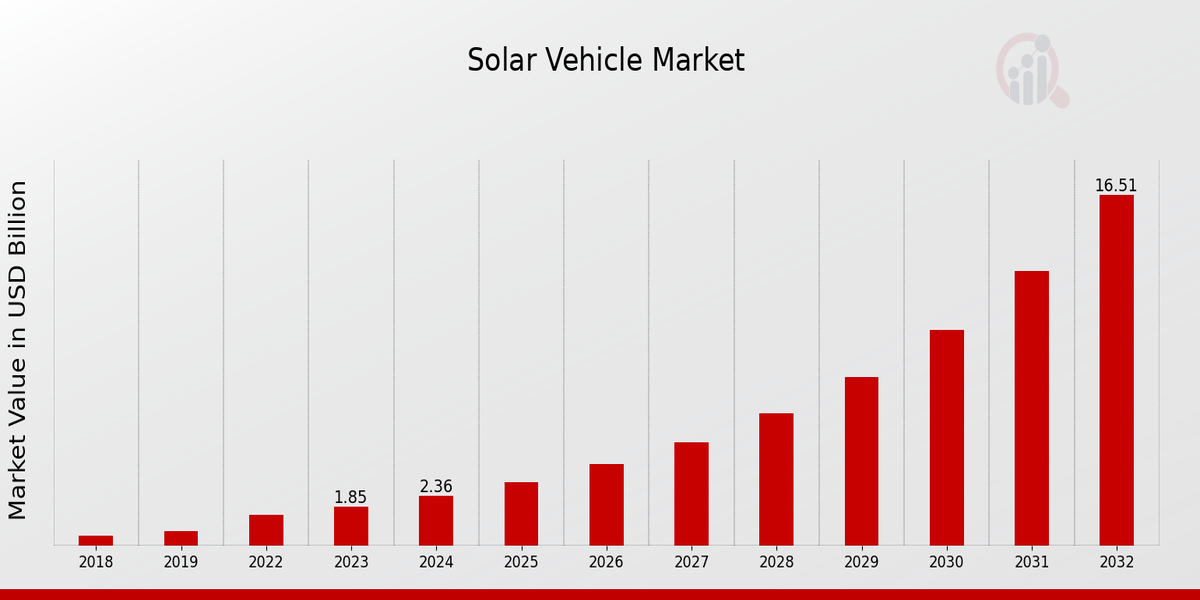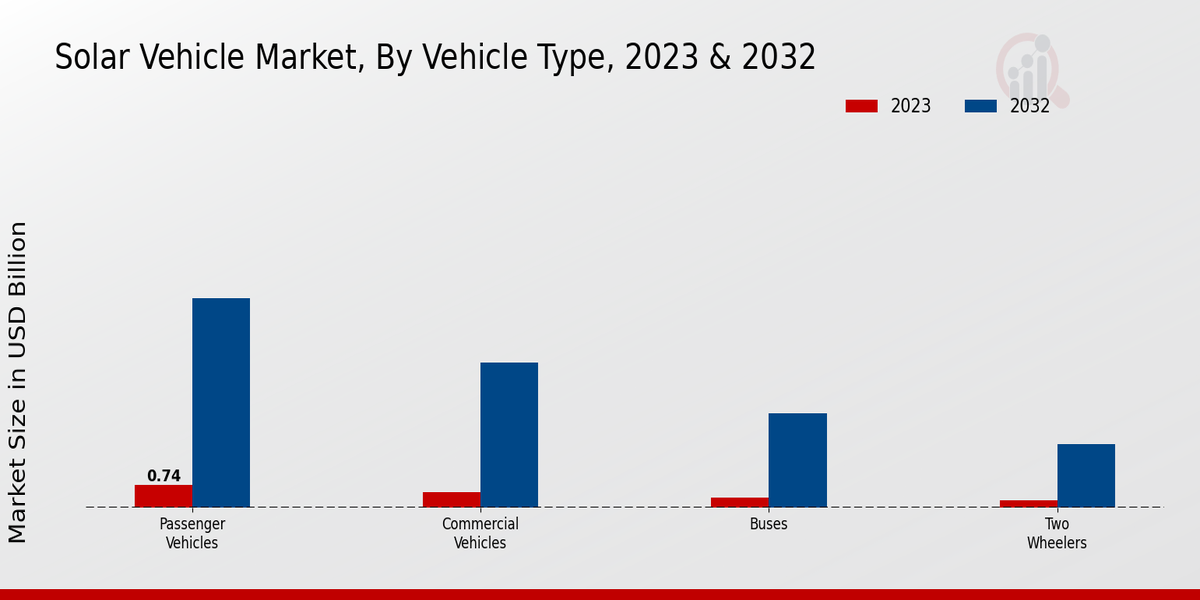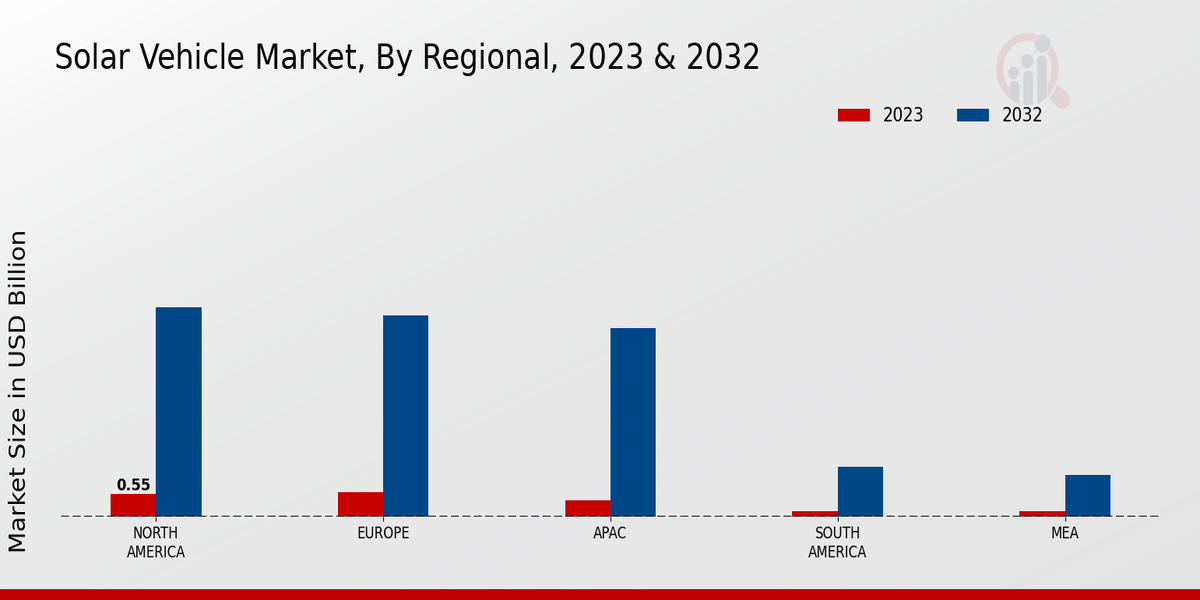Solar Vehicle Market Overview
As per MRFR analysis, the Solar Vehicle Market Size was estimated at 1.45 (USD Billion) in 2022. The Solar Vehicle Market is expected to grow from 1.85 (USD Billion) in 2023 to 16.5 (USD Billion) by 2032. The Solar Vehicle Market CAGR (growth rate) is expected to be around 27.52% during the forecast period (2024 - 2032).
Key Solar Vehicle Market Trends Highlighted
The growing emphasis on environmentally friendly transportation is propelling the global market for solar vehicles.
This trend is primarily driven by environmental concerns about emissions from fossil fuels and the demand for cleaner, renewable energy sources. To encourage the use of electric vehicles, governments around the world are enacting stronger laws and providing incentives.
Furthermore, improvements in energy storage and solar panel efficiency brought about by technology developments have increased the viability of solar-powered automobiles. As consumers grow more accustomed to using solar energy for their transportation needs, the market's growth is further supported by the expanding availability of charging infrastructure.
Opportunities in the global market for solar vehicles are growing. Solar technology advancements offer a chance to reduce expenses and make cars more accessible to a wider range of people. Partnerships between solar tech firms and automakers are opening the door to innovative features and designs that improve user experience.
As consumer awareness about the benefits of solar vehicles increases, there is a strong potential for market growth. The trend towards sustainability is encouraging businesses to develop solar solutions, allowing them to capture a larger share of an eco-conscious customer base eager for clean transportation options.
Recent times have seen a growing trend of integrating smart technology into solar vehicles. Features such as real-time monitoring of solar energy usage, improved battery management systems, and vehicle-to-grid technologies are becoming more common. Electric vehicle manufacturers are increasingly focusing on sustainability measures that go beyond just the vehicle, incorporating eco-friendly materials and practices in production.
The rise of shared mobility solutions also presents opportunities for solar-powered vehicles, creating a unique niche in the personal and commercial transport sectors. Overall, the momentum within the solar vehicle market indicates a transition toward sustainable and innovative transportation solutions.

Source: Primary Research, Secondary Research, MRFR Database and Analyst Review
Solar Vehicle Market Drivers
Increasing Environmental Awareness
The Global Solar Vehicle Market is witnessing a significant surge in demand due to increasing environmental awareness among consumers and businesses alike. As climate change concerns grow, there is a collective push toward adopting sustainable transportation solutions.
Solar vehicles present a viable alternative to traditional fuel-powered vehicles, as they harness renewable energy from the sun, reducing greenhouse gas emissions. The electrical emissions from conventional vehicles are contributing to air pollution and global warming.
Solar vehicles not only address these issues but also promise lower operating costs over their lifecycle, thereby appealing to cost-conscious consumers. Governments around the world are also initiating policies and programs promoting green technologies and sustainable urban transport solutions.
These policies involve subsidies for solar vehicles, financial incentives for manufacturers, and investments in solar infrastructure. As more people understand the benefits of renewable energy and the urgent need for cleaner transportation options, the market for solar vehicles is expected to grow rapidly.
This growing public consciousness around sustainability is paving the way for innovations in the Global Solar Vehicle Market, making it an attractive prospect for manufacturers and investors looking to capitalize on the green revolution.
Technological Advancements in Solar Technology
The rapid advancements in solar technology are propelling the Global Solar Vehicle Market forward. Innovations in photovoltaic cells, battery storage, and energy management systems have significantly improved the efficiency and performance of solar vehicles.
Developments in lightweight materials and energy conversion technologies have allowed manufacturers to create vehicles that are not only more energy-efficient but also more user-friendly.
This technological evolution is critical in enhancing the practicality and attractiveness of solar vehicles to a wider audience, thus driving market growth.
Government Initiatives and Incentives
Government policies and incentives play a crucial role in promoting the Global Solar Vehicle Market. Many countries are implementing frameworks to support the transition towards renewable energy, offering tax breaks, subsidies, and grants for both manufacturers and consumers in the solar vehicle sector. Such initiatives lower the barriers to entry for new technologies and encourage consumer adoption, significantly enhancing market prospects.
Solar Vehicle Market Segment Insights
Solar Vehicle Market Vehicle Type Insights
The Solar Vehicle Market operates within a diverse framework of vehicle types, demonstrating significant potential for growth and innovation.
Passenger vehicles emerged as a dominant player in this market segment, valued at 0.74 USD Billion in 2023 and projected to reach 6.79 USD Billion by 2032. This significant market share can be attributed to the growing demand for eco-friendly transportation solutions, as consumers increasingly prioritized sustainable options in their mobility choices.
Commercial vehicles also held a critical position, with a valuation of 0.52 USD Billion in 2023, likely to grow to 4.71 USD Billion by 2032. This segment's importance lies in its potential to revolutionize logistics and transportation industries through reduced operational costs and environmental impact, making them increasingly attractive to businesses aiming for sustainability.
Buses played a notable role as well, valued at 0.34 USD Billion in 2023 and expected to expand to 3.07 USD Billion by 2032. The shift toward electric and hybrid public transport solutions underscored the growing movement toward sustainable urban mobility.
The two-wheelers segment, while smaller, still contributed to the overall market, with a valuation of 0.25 USD Billion in 2023 and projected growth to 2.08 USD Billion by 2032. This segment's significance lies in its ability to meet individual consumers' increasing need for personal mobility that is both efficient and environmentally friendly.
In summary, the Solar Vehicle Market segmentation by vehicle type illustrates a dynamic landscape with equally compelling opportunities across these segments. As trends toward green technologies continue to gain traction, the market reflects a promising trajectory supported by shifting consumer preferences, regulatory incentives, and technological advancements aimed at enhancing the efficiency of solar vehicles.
The growth drivers in these segments included technological innovations, increasing environmental consciousness among consumers, and government support for clean energy initiatives, ultimately reshaping the transportation sector to be more sustainable. However, challenges such as infrastructure development and market acceptance remain.
The ongoing developments within each vehicle type presented considerable opportunities for stakeholders in the Solar Vehicle Market, aiming to harness renewable energy while addressing the transportation needs of a rapidly evolving society.

Source: Primary Research, Secondary Research, MRFR Database and Analyst Review
Solar Vehicle Market Solar Technology Insights
Within the solar technology segment, key technologies such as photovoltaic cells, concentrated solar power, and building-integrated photovoltaics play crucial roles. Photovoltaic cells dominate the market due to their efficiency in converting sunlight directly into electricity, making them a preferred choice in solar vehicles. Concentrated solar power harnesses solar energy through mirrors or lenses, providing sustainable energy solutions for larger applications.
Building-integrated photovoltaics are increasingly important as they allow for the seamless integration of solar technology into building structures, promoting energy efficiency and aesthetic appeal. These segments contribute significantly to the overall prevalence of solar vehicles by providing innovative solutions that support clean energy targets and reduce reliance on conventional fuel sources.
The overall Solar Vehicle Market data reveals robust opportunities aligned with growing environmental concerns and advancements in solar technologies.
Solar Vehicle Market Vehicle Drive Type Insights
The Solar Vehicle Market exhibits significant growth potential, particularly in the Vehicle Drive Type segment. This segment plays a crucial role in determining the performance and efficiency of solar vehicles, driving consumer preferences and market dynamics.
Among the different vehicle drive types, All Wheel Drive systems are recognized for their enhanced traction and stability, making them preferable in diverse driving conditions. Additionally, Front Wheel Drive configurations are gaining traction due to their space efficiency and cost-effectiveness, often appealing to urban drivers.
Meanwhile, Rear Wheel Drive remains a strong choice for performance-oriented vehicles, catering to a niche market focused on driving experience. The segmentation of the Solar Vehicle Market reflects the important trends shaped by technological advancements and evolving consumer expectations in the automotive industry.
As the Solar Vehicle Market seeks to expand, addressing the unique characteristics and advantages of each drive type will be key to leveraging growth opportunities and meeting the demands of an increasingly eco-conscious consumer base.
Solar Vehicle Market End Use Insights
The End Use segment of the Solar Vehicle Market plays a crucial role in the industry's development, with multiple applications across various domains driving growth. The Private Use segment is gaining traction as consumers increasingly seek eco-friendly alternatives for personal transportation, emphasizing the need for solar vehicles that reduce carbon footprints.
Meanwhile, Public Transport is becoming a focal point, with municipalities looking to decrease operating costs and environmental impact, thereby adopting solar technology for buses and other transit options.
The Logistics sector significantly benefits from solar vehicles, particularly in reducing fuel expenses and enhancing operational efficiency as demand for sustainable delivery methods rises. Each of these areas within the Solar Vehicle Market segmentation contributes to a comprehensive understanding of market trends, with notable statistics highlighting the positive momentum behind solar vehicle adoption and resulting market growth.
With evolving technology and rising environmental awareness, the landscape for these end-use applications is poised for continual advancement, revealing opportunities within the Global Solar Vehicle Market.
Solar Vehicle Market Regional Insights
The market expansion highlighted the increasing focus on renewable energy and sustainable transportation solutions across various regions. North America stood out with a valuation of 0.55 USD Billion in 2023 and is expected to dominate with 5.0 USD Billion in 2032, driven by technological advancements and government initiatives promoting clean energy.
Europe closely followed, valued at 0.6 USD Billion in 2023 and anticipated to be valued at 4.8 USD Billion by 2032, reflecting robust support for electric vehicles.
The APAC region, though initially valued lower at 0.4 USD Billion in 2023, is projected to reach 4.5 USD Billion in 2032, showcasing its potential as a significant market due to increasing urbanization.
South America and the MEA regions, both valued at 0.15 USD Billion in 2023, are expected to rise to 1.2 USD Billion and 1.0 USD Billion, respectively, by 2032, albeit they remained the least dominant in the market while presenting growth opportunities.
The shifting consumer preferences towards solar vehicles and supportive policies across these regions signified a substantial trend in the Global Solar Vehicle Market.

Source: Primary Research, Secondary Research, MRFR Database and Analyst Review
Solar Vehicle Market Key Players and Competitive Insights:
The Solar Vehicle Market is witnessing a transformative phase driven by increasing environmental awareness, technological advancements, and support from government policies. As the world pivots toward sustainable transportation solutions, solar vehicles have emerged as a viable alternative to traditional internal combustion engine vehicles.
This market encompasses a variety of manufacturers, ranging from traditional automotive companies adapting their models to include solar technology to new entrants focusing solely on solar-powered innovations. Competitive dynamics are characterized by intense research and development activities, strategic partnerships, and collaborations aimed at enhancing solar technology efficiency.
Companies are investing in improving energy conversion rates of solar panels and integrating innovative power storage solutions, further propelling growth in this burgeoning market. As consumer demand shifts towards greener transportation options, market players are vying for a competitive edge through unique features, pricing strategies, and brand positioning.
In the context of the Solar Vehicle Market, Toyota emerges as a significant player leveraging its longstanding experience in hybrid and electric vehicle manufacturing. The company's robust research and development framework enables it to develop high-efficiency solar integration systems that provide enhanced energy generation capabilities.
Toyota's strong brand reputation, recognized globally for quality and innovation, along with its commitment to sustainability, strengthens its position in this competitive landscape.
Furthermore, Toyota demonstrates a proactive approach to leveraging partnerships with technology firms to optimize solar technologies in its vehicles. Additionally, Toyota's extensive distribution networks and established customer base provide a solid platform for launching solar vehicles, ensuring greater market presence and accessibility.
The company's strategic focus on advancing solar vehicle prototypes positions it favorably in capturing the growing demand for renewable-energy-driven mobility solutions.
Aptera Motors presents a compelling vision in the Solar Vehicle Market with its unique approach to vehicle design and functionality, making it a noteworthy contender in this rapidly evolving sector. The company focuses exclusively on solar electric vehicles that offer a distinctive blend of efficiency, minimalism, and sustainability.
Aptera Motors has integrated advanced solar panels into its vehicle design, enabling it to harness solar energy effectively, thus reducing reliance on traditional charging infrastructures. The company emphasizes high energy efficiency, lightweight materials, and aerodynamic shapes, which contribute to superior performance and extended driving ranges powered by renewable energy.
Aptera Motors's innovation lies in its ability to combine solar power with electric propulsion, showcasing not only an environmental commitment but also a vision for future mobility. Its market entry strategy capitalizes on sustainability trends and consumer interest in alternative energy vehicles, finely positioning itself for potential growth within the solar vehicle segment.
Key Companies in the Solar Vehicle Market Include:
- Toyota
- Aptera Motors
- Volkswagen
- Lightyear
- Hyundai
- Fisker
- Nissan
- Ford
- Tesla
- Rivian
- Audi
- Proterra
- Lucid Motors
- Mercedes-Benz
- BMW
Solar Vehicle Market Developments
There have been significant advancements in the Solar Vehicle Market, particularly with major automotive players enhancing their focus on solar technology integration. Toyota has announced a continued investment in solar panel technology for vehicles, aiming to improve efficiency and sustainability. Aptera Motors has gained attention for its innovative solar electric vehicle design that allows for optimal energy usage, emphasizing energy independence for drivers.
Volkswagen is exploring partnerships to develop solar charging infrastructure for electric vehicles, aligning with their ambition to expand their EV portfolio. Lightyear has officially launched its Lightyear 0, a solar electric vehicle that utilizes integrated solar panels for added range.
Hyundai continues to innovate with its solar roof technology, enhancing the overall performance of its electric models. In terms of mergers and acquisitions, Rivian is reportedly in talks to collaborate with Ford on joint solar initiatives, while Tesla is actively working on expanding its solar energy services to complement its vehicle offerings.
This growth reflects a rising market valuation for companies in the sector as they pivot towards sustainable energy solutions and witness increasing demand for eco-friendly transportation options. These developments indicate a dynamic and rapidly evolving landscape in the solar vehicle industry.
Solar Vehicle Market Segmentation Insights
Solar Vehicle Market Vehicle Type Outlook
- Passenger Vehicles
- Commercial Vehicles
- Buses
- Two Wheelers
Solar Vehicle Market Solar Technology Outlook
- Photovoltaic Cells
- Concentrated Solar Power
- Building-Integrated Photovoltaics
Solar Vehicle Market Vehicle Drive Type Outlook
- All Wheel Drive
- Front Wheel Drive
- Rear Wheel Drive
Solar Vehicle Market End Use Outlook
- Private Use
- Public Transport
- Logistics
Solar Vehicle Market Regional Outlook
- North America
- Europe
- South America
- Asia Pacific
- Middle East and Africa
|
Report Attribute/Metric
|
Details
|
|
Market Size 2022
|
1.45 (USD Billion)
|
|
Market Size 2023
|
1.85 (USD Billion)
|
|
Market Size 2032
|
16.5 (USD Billion)
|
|
Compound Annual Growth Rate (CAGR)
|
27.52% (2024 - 2032)
|
|
Report Coverage
|
Revenue Forecast, Competitive Landscape, Growth Factors, and Trends
|
|
Base Year
|
2023
|
|
Market Forecast Period
|
2024 - 2032
|
|
Historical Data
|
2019 - 2023
|
|
Market Forecast Units
|
USD Billion
|
|
Key Companies Profiled
|
Toyota, Aptera Motors, Volkswagen, Lightyear, Hyundai, Fisker, Nissan, Ford, Tesla, Rivian, Audi, Proterra, Lucid Motors, MercedesBenz, BMW
|
|
Segments Covered
|
Vehicle Type, Solar Technology, Vehicle Drive Type, End Use, Regional
|
|
Key Market Opportunities
|
Increased demand for sustainable transport, Government incentives for solar adoption, Advancements in solar technology efficiency, Integration of solar with EVs, Growing environmental awareness among consumers
|
|
Key Market Dynamics
|
growing environmental concerns, advancements in solar technology, government incentives and subsidies, increasing fuel prices, rising demand for sustainable transport
|
|
Countries Covered
|
North America, Europe, APAC, South America, MEA
|
Frequently Asked Questions (FAQ) :
The Solar Vehicle Market is expected to be valued at 16.5 USD Billion in 2032.
The expected CAGR for the Solar Vehicle Market from 2024 to 2032 is 27.52%.
North America is projected to have the largest market share in the Solar Vehicle Market, valued at 5.0 USD Billion by 2032.
The market value for Passenger Vehicles in the Solar Vehicle Market is expected to reach 6.79 USD Billion by 2032.
Key players in the Solar Vehicle Market include Toyota, Volkswagen, Lightyear, Tesla, and Hyundai.
The market size for Commercial Vehicles in the Solar Vehicle Market is estimated to be 4.71 USD Billion in 2032.
The APAC region is expected to grow to a market size of 4.5 USD Billion by 2032.
In 2023, the Solar Vehicle Market was valued at 1.85 USD Billion.
The market value for Buses in the Solar Vehicle Market is expected to reach 3.07 USD Billion by 2032.
The market size for Two Wheelers in the Solar Vehicle Market is projected to be 2.08 USD Billion in 2032.

















